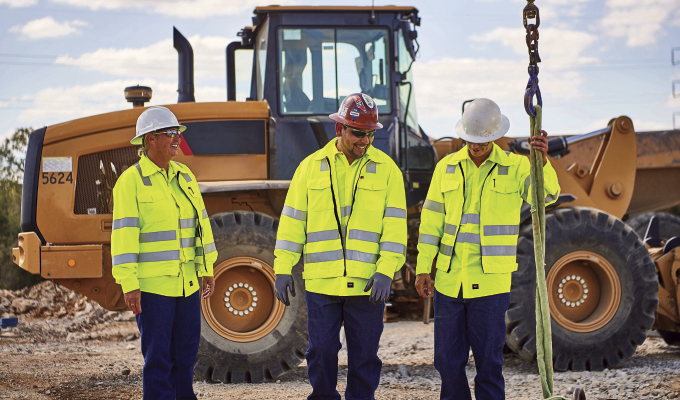In the commercial construction industry, accidents like slips, trips, and falls have increased by a small, but not insignificant, amount over the last couple of years.
There are plenty of risks that commercial construction workers, project managers, and other leaders face daily. However, there are also many steps these professionals can take to maintain a safe and productive worksite.
If you want to make your commercial construction site safer, this guide can help. Learn how to optimize safety for workers on commercial construction sites below.
COMMON HAZARDS
Regardless of the size or scope of the project, commercial construction sites can be perilous places. Here are some of the most well-known hazards commercial construction workers face regularly:
- Falls (especially from ladders)
- Slips and trips (often caused by substances like mud or grease, as well as issues like debris or equipment that has not been put away correctly)
- Toxic substance exposure (including exposure to minerals like lead and chromium, as well as asbestos)
- Struck-by incidents (employees being hit by vehicles, falling objects, etc.)
- Excessive noise exposure
- Vibration-related injuries (including back pain, altered body movements, and speech difficulties)
- Electrical incidents
- Burns (from chemicals and heat exposure)
TRAINING, EDUCATION MATTER
As you can see, a lot can go wrong on even the most carefully managed construction sites. That’s why comprehensive safety training and education are so necessary. The following are some of the most significant benefits of thorough safety training:
- Fewer accidents and injuries
- Fewer project delays while teams try to get back on track after an accident or injury
- Reduced chances of being short-staffed because employees are out with injuries
- Reduced risk of lawsuits from employees who get hurt on the job
- Improved morale across all team members
- Easier recruiting and employee retention
- Better reputation among clients, suppliers, and the overall community
It’s also important to note that safety training should be ongoing. It’s not enough to provide one training course and assume your employees know everything they need to know to protect themselves and their coworkers.
HOW TO OPTIMIZE SAFETY
In addition to regular and comprehensive safety training, you can take many other steps to optimize safety for commercial construction crews. Here are some of the most effective strategies to implement today:
Use Personal Protective Equipment (PPE): Having access to and using the proper personal protective equipment can significantly reduce the risk of severe injuries and fatalities on commercial construction sites. At a minimum, it’s recommended that commercial construction workers wear hard hats, sturdy work shoes or boots, and safety glasses. If they will be exposed to vehicular traffic, they should also wear high-visibility safety vests. Depending on circumstances and the risk of exposure to certain hazards, crew members may also need additional gear, such as protective gloves, hearing protection, and face shields.
Maintain Clear Communication: Clear communication plays a critical role in preventing accidents from happening on commercial construction sites (and all construction sites). In addition to delivering clear instructions to all team members, it also helps to utilize modern technology like smartphones, tablets, and construction management software. These tools allow for more efficient, real-time communication, especially between people on the jobsite and those back at the office.
Adhere to Safety Regulations and Standards: The Occupational Safety and Health Administration has clear, research-backed recommendations to help employees stay safe while on construction sites. For example, they encourage ongoing training, transparent reporting systems, and hazard control implementation. OSHA also has specific requirements in place for preventing common construction site injuries. For example, they expect employees to do the following to prevent falls from roofs:
- Wear harnesses and always stay connected
- Ensure harnesses fit correctly
- Use guardrails and lifelines
- Inspect fall protection equipment thoroughly before each use
- Guard or cover holes, openings, and skylights
Encourage Accountability: Accountability is critical among construction crew members, leaders, owners, and other stakeholders. Employees should be encouraged to report potential hazards or dangerous practices. Leaders should also take these reports seriously and enforce consequences or escalate them to the proper authorities. If everyone knows that they will be held accountable for their actions, they will be more inclined to engage in safe practices while on the job.
Conduct Daily Site Inspections and Safety Meetings: Daily site inspections and safety meetings can also create a sense of accountability on the jobsite. Ideally, inspections will occur before and after each workday. These inspections create opportunities to catch tools left lying around, damaged equipment, and other potential hazards.
A brief safety meeting at the beginning of the workday also helps to ensure everyone is on the same page regarding the tasks that must be performed and how to stay safe while executing them. This meeting also gives workers a chance to ask questions or express concerns.
Service and Update Equipment Consistently: During daily inspections, looking for signs of damaged or malfunctioning equipment is essential. If a project manager or another leader notices that equipment needs a tune-up or repair, they should schedule that as quickly as possible. They should also arrange for regular equipment services to prevent malfunctions and extend their lifespan.
Document and Track Safety Incidents: Proper documentation and tracking create a sense of accountability. They also provide valuable data that employers and owners can reference over time. For example, say an employer notices that there have been several fall-related incidents in the last three months. In that case, they will know that they need to provide extra training on fall prevention or invest in additional equipment.
CLOSING THOUGHT
Owners, project managers, and other leaders must prioritize safety for all employees working on commercial construction sites. A good place for them to start is by evaluating job sites and making adjustments based on the guidelines discussed above.
Simple changes like using the proper personal protective equipment, documenting safety incidents, and conducting daily site inspections and safety meetings can have a positive impact on the entire crew and create a safer, more efficient, and more productive workplace for everyone involved.

About the Author:
Nick Warrick is the Sales Manager at All Seasons Uniforms. With over 15 years of experience in the work uniform business, he has worked with over 100 clients across 20 different industries. Holding bachelor’s degrees in both Business Administration and Information Technology, Warrick revamped the company’s online presence, offering its customers a new uniform shopping experience. For more, visit www.allseasonsuniforms.com.
Modern Contractor Solutions, October 2023
Did you enjoy this article?
Subscribe to the FREE Digital Edition of Modern Contractor Solutions magazine.



